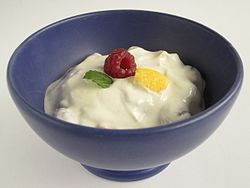Yoghurt

A bowl of yogurt garnished with fruit and mint
|
|
| Type | Dairy product |
|---|---|
| Serving temperature | Chilled |
| Main ingredients | Milk, bacteria |
| |
|
| Nutritional value per 100 g (3.5 oz) | |
|---|---|
| Energy | 406 kJ (97 kcal) |
|
3.98 g
|
|
| Sugars | 4.0 g |
| Dietary fiber | 0 g |
|
5.0 g
|
|
|
9.0 g
|
|
| Vitamins | |
| Vitamin A equiv. |
(0%)
26 μg22 μg
|
| Thiamine (B1) |
(2%)
0.023 mg |
| Riboflavin (B2) |
(23%)
0.278 mg |
| Niacin (B3) |
(1%)
0.208 mg |
| Pantothenic acid (B5) |
(7%)
0.331 mg |
| Vitamin B6 |
(5%)
0.063 mg |
| Folate (B9) |
(1%)
5 μg |
| Vitamin B12 |
(31%)
0.75 μg |
| Choline |
(3%)
15.1 mg |
| Vitamin C |
(0%)
0 mg |
| Minerals | |
| Iron |
(0%)
0 mg |
| Magnesium |
(3%)
11 mg |
| Manganese |
(0%)
0.009 mg |
| Phosphorus |
(19%)
135 mg |
| Potassium |
(3%)
141 mg |
| Sodium |
(2%)
35 mg |
| Zinc |
(5%)
0.52 mg |
| Other constituents | |
| Selenium | 9.7 µg |
| Water | 81.3 g |
|
|
|
|
|
| Percentages are roughly approximated using US recommendations for adults. | |
Yogurt, yoghurt, or yoghourt (/ˈjoʊɡərt/ or /ˈjɒɡət/; from Turkish: yoğurt; other spellings listed below) is a food produced by bacterial fermentation of milk. The bacteria used to make yogurt are known as "yogurt cultures". Fermentation of lactose by these bacteria produces lactic acid, which acts on milk protein to give yogurt its texture and characteristic tart flavor.Cow's milk is commonly available worldwide, and, as such, is the milk most commonly used to make yogurt. Milk from water buffalo, goats, ewes, mares, camels, and yaks is also used to produce yogurt where available locally. Milk used may be homogenized or not (milk distributed in many parts of the world is homogenized); both types may be used, with substantially different results. In North America, yogurt is sold plain, sweetened (with honey, sugar, or sugar substitutes), or sweetened and flavoured with fruit, vanilla, coffee and other flavours.
...
Wikipedia
